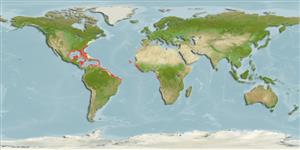Common names from other countries
>
Beloniformes (Needle fishes) >
Exocoetidae (Flyingfishes)
Etymology: Hirundichthys: latin, hirundo = swift; 1300 + Greek, ichthys = fish (Ref. 45335).
More on author: Günther.
Environment: milieu / climate zone / depth range / distribution range
экология
морской; мигрирует в океане (Ref. 51243); пределы глубины 0 - 100 m (Ref. 5217). Subtropical; 41°N - 13°S, 98°W - 14°E
Eastern Atlantic: Guinea to Angola. Western Atlantic: Gulf Stream off Virginia, USA and northern Gulf of Mexico to northern Brazil (Ref. 7251), including the Caribbean Sea (Ref. 3720). Northwest Atlantic: Canada (Ref. 5951).
Length at first maturity / Size / Вес / Возраст
Maturity: Lm 25.1 range ? - ? cm
Max length : 33.0 cm TL самец/пол неопределен; (Ref. 109257); common length : 24.0 cm TL самец/пол неопределен; (Ref. 5217); наибольший возраст (опубликованны данные): 1.00 годы (Ref. 6503)
колючие лучи спинного плавника (общее число) : 0; членистые (мягкие) лучи спинного плавника (общее число) : 11; колючие лучи анального плавника: 0; членистые (мягкие) лучи анального плавника: 11 - 12. Body elongate, thick, somewhat flattened ventrally; snout shorter than eye, blunt; palatine teeth usually absent; dorsal and anal fins set far back on body, their bases short; dorsal fin low, rays at anterior end the longest; anal fin origin slightly before, or 1 or 2 rays behind dorsal fin origin; pectoral fins strikingly long, 60 to 70 % of SL, only first ray unbranched; pelvic fins large, reaching well beyond anal fin origin; more than 25 scale rows of predorsal scales; dorsally, the color is usually iridescent blue or green in life; dorsal fin colorless or only slightly pigmented; pectoral fins dark, with a pale basal triangle and a narrow white margin (on trailing edge when extended) (Ref. 3720).
Occurs in surface waters both near and far from the coast (Ref. 5217). Forms schools. Capable of leaping out and gliding for long distances above the water. Seasonal variation in abundance was noted in the eastern Caribbean countries, a phenomenon that may be due to post-spawning mortality (Ref. 6838). The most important commercial fish species of the eastern Caribbean (Ref. 6504). Considered a good food fish; marketed fresh.
Spawns on the water surface and to a depth of 20 m (Ref. 6834). Post-spawning mortality may explain the disappearance of mature cohorts at the close of the spawning season in June (Ref. 6838).
Gibbs, R.H. Jr., 1978. Exocoetidae. In W. Fischer (ed.) FAO species identification sheets for fishery purposes. Western Central Atlantic (Fishing Area 31). Vol. 2. pag.var. (Ref. 3720)
Статус Красного Списка МСОП (Ref. 130435)
CITES (Ref. 128078)
Not Evaluated
Угроза для людей
Harmless
Использование человеком
рыболовство: коммерческий; наживка: usually
дополнительная информация
инструменты
Специальные отчеты
Скачать в формате XML
ресурсы в Интернет
Estimates based on models
Preferred temperature (Ref.
115969): 14.3 - 23.6, mean 20 (based on 39 cells).
Phylogenetic diversity index (Ref.
82804): PD
50 = 0.5002 [Uniqueness, from 0.5 = low to 2.0 = high].
Bayesian length-weight: a=0.00794 (0.00415 - 0.01521), b=3.01 (2.83 - 3.19), in cm Total Length, based on LWR estimates for this species & (Sub)family-body (Ref.
93245).
Trophic level (Ref.
69278): 3.8 ±0.56 se; based on food items.
устойчивость к внешним воздействиям (Ref.
120179): высокий, минимальное время удвоения популяции до 15 месяцев (tm<1; tmax=1).
Fishing Vulnerability (Ref.
59153): Low vulnerability (16 of 100).
